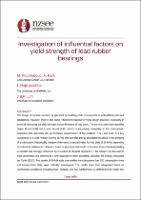Investigation of influential factors on yield strength of lead rubber bearings

Download
Date
2022-04-27Authors
Pourmasoud, M Masoud
Park, Alan
Hajirasouliha, Iman
Lim, James
Metadata
Show full item recordAbstract
The design of seismic isolators as specified by building code requirements is well defined and well established. However, there is still some refinement required for these design practices, especially in terms of estimating the yield strength and confinement of lead cores. The current codes have specified Upper Bound (UB) and Lower Bound (LB) criteria to encompass variability in the characteristic properties that determine the performance requirements of the isolators. The Lead Core is a key component in a Lead Rubber Bearing (LRB) that provides energy absorption resulting in the damping of a unit/system. Historically, designers have used a standard value for lead yield (8-10 MPa) depending on individual preferences. However, based on prototype test results, it has been shown that lead yielding is variable and strongly influenced by a number of physical parameters. This research has focused on these parameters and determines a new approach to more accurately calculate the Energy Dissipated per Cycle (EDC). Test results of 30 full-scale case studies, including more than 350 compression-shear and tension-shear tests, were critically investigated. The results were then categorised based on confinement conditions, including high, medium, and low confinement, as defined further within this paper. The results illustrate that appropriate confinement provides a high yield strength level and ultimately an optimised seismic isolation design. The trend of yield strength index versus the stability index was developed and a new equation was proposed to calculate the lead core’s yield strength for practical design purposes.
